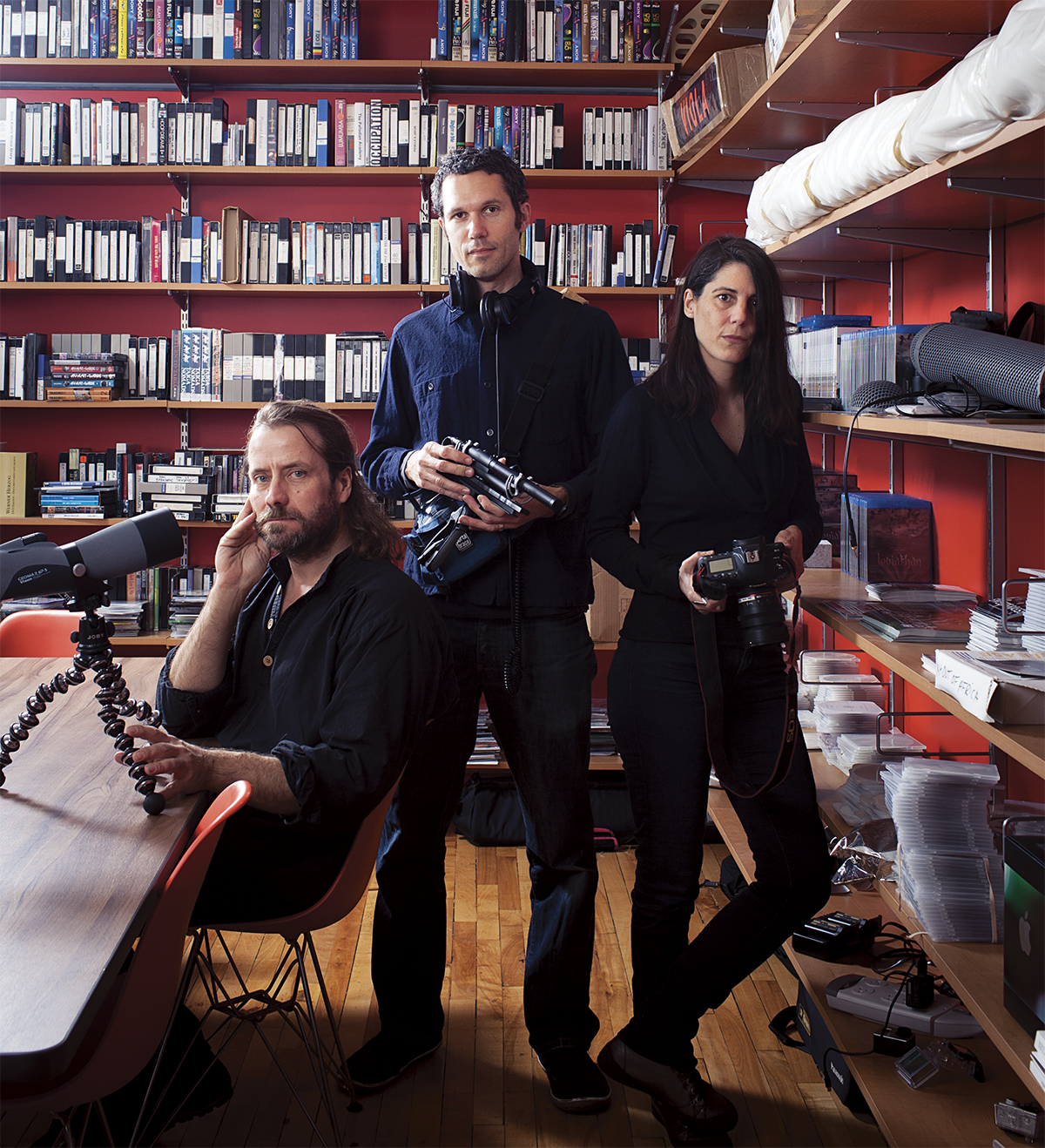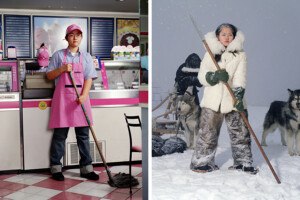Spring Arts Preview 2014


Lucien Castaing-Taylor, Ernst Karel, and Véréna Paravel of Harvard’s Sensory Ethnography Lab. / Photograph by Jarrod McCabe
The Cruelty of Reality
At Harvard, meet the lab that’s creating a new kind of cinema. —Peter Keough
Harvard’s Sensory Ethnography Lab is hard to find. An interdisciplinary program scattered about the university, it is nowhere in particular and everywhere in general: Its minuscule staff and handful of students draw on the resources of the Harvard Film Archive, the Film Study Center, and the Anthropology Department. As Stephanie Spray, co-director of their newest film, Manakamana (which opens in Boston in April or May), jokingly puts it, it’s “in the cloud.”
You could almost say that SEL is not so much a place as a state of mind that fuses scientific objectivity and an almost spiritual faith in the power of film. And yet the laboratory has formulated a ferocious new documentary style that is transforming nonfiction filmmaking, and maybe cinema itself.
Take SEL’s last release, Leviathan (2012), directed by the anthropologist Lucien Castaing-Taylor and Véréna Paravel. The camera’s eye descends into the maw of a New Bedford fishing vessel as it sucks up and processes sea life. The filmmakers shoot from wherever their GoPro cameras can find access: underwater, between the legs of fishermen, upside down staring into the abstract patterns of angry seagulls, or eye to eye with a deck full of sloshing, half-dead marine creatures.
They edited the resulting footage into 87 kaleidoscopic minutes, set against a palpable, near-painful soundtrack orchestrated by SEL co-director and sound specialist Ernst Karel. The experience ranges from serene, psychedelic Escher-like patterns to the cinematic equivalent of waterboarding.
SEL was founded in 2006 by Castaing-Taylor, and in some ways its approach resembles conventional ethnographic filmmaking: For Leviathan, Paravel tells me via email, she and Castaing-Taylor “went out on six trips, for a total of perhaps two and a half months at sea…and ended up with around 300 hours of rushes.” At the same time, though, the SEL technique draws on the subjectivity of first-person documentaries—but without the filmmaker appearing on camera. Most important, it leaves out an element common to both of those nonfiction approaches: language.
Despite, or because of, this, Leviathan did a respectable run in art houses and later on DVD and Blu-ray discs. It was successful enough for Hollywood studios to contact them to find out how they’d achieved their effects.
So far, though, SEL has made its biggest impression on critics, scholars, and cinephiles. The films have gotten rave reviews, won festival prizes, and appeared on the year-end lists of publications including the New York Times and the New Yorker. And in April and May, SEL productions will be featured simultaneously in Lincoln Center’s “Art of the Real” program and at the Whitney Biennial. Says Lincoln Center program director Dennis Lim, “These films have already been influential in expanding many people’s ideas of what a documentary could be. My guess is that Leviathan in particular will come to be seen as one of the most influential films of our time.”
Castaing-Taylor, for his part, finds all the fuss embarrassing. “I think it’s stupid,” he says of the hype. “They’re always on the lookout for some new fashion.”
We’re sitting in an SEL studio in a modest building on the fringes of the Harvard campus. It consists of three rooms, one of which is full of computers and editing equipment. No one is using them at the moment.
On the coffee table next to us rests a plastic model of a human brain beside a book on Chernobyl. A painting of a carcass (Untitled, from Maxwell’s Lair, by Emilie Clark) dominates one wall. On another wall hangs a horse’s skull punctured by a bullet hole, a souvenir of Castaing-Taylor’s days making Sweetgrass (2009), a film about a sheep roundup in Montana that he co-directed with Ilisa Barbash. A whiff of incense lingers, perhaps sandalwood.
Genial and bearded with a Liverpool accent, the fortyish Castaing-Taylor asks to be quoted not at all, or as little as possible. He doesn’t want to be the center of attention.
We talk for more than an hour. He explains how, unlike most ethnographic documentaries that try “to express in propositional prose the sense of the infinite magnitude of human existence that can’t be transcribed,” their films try to move beyond voice-overs and talking heads to confront raw existence.
For his next project, Castaing-Taylor is making a feature combining fiction and nonfiction. “It’s about sex and cannibalism,” he says. “What is more basic to human existence than sexual desire?”
Cannibalism? I ask. He points out how cannibalism has been a prominent topic in the history of anthropology, though mostly the ritualistic kind practiced in non-Western cultures. But he is more interested in “sexual cannibalism,” the modern, consensual kind in which people advertise on websites for someone to have sex with them and then eat them. “It happened in Germany,” he says, adding, “It’s illegal.”
Before I leave he insists that I talk with other SEL members. They are more articulate, he says. And don’t mind being quoted.
I had already called on Stephanie Spray, who is on campus. We talk in a quiet office in Sever Hall’s Film Study Center.
I had just seen her film Manakamana. Where Leviathan assaults, Manakamana soothes. But both challenge the viewer.
The premise is deceptively simple. In Nepal, Spray and her collaborator Pacho Velez make trips in a cable car with pilgrims to the shrine of the title deity. The film consists of single takes from a fixed camera facing the other passengers, each shot running the entire 10-minute trip to the temple. Then they do the same with a different party going back again. Each trip, back or forth, ends in the din and darkness of the station.
It’s like riding the Green Line and spying on people, wondering about their lives. Every gesture and glance takes on significance and mystery. Here you’re doing the same when, bang, the darkness comes, and it starts again.
I ask Spray, “Is this a metaphor for death and rebirth?”
“Samsara,” she agrees. “It’s an attempt to touch the real. Not that there is any absolute.”
On the desk I notice the book Let Us Now Praise Famous Men, the film critic James Agee’s collaboration with the photographer Walker Evans, an account of their eight-week sojourn with Alabama sharecroppers during the Depression. It’s required reading for SEL students.
“It’s our bible,” Castaing-Taylor says when I ask him about it. He quotes from the book: “‘The cruel radiance of what is.’ That’s our goal. To get away from the conventions that constrain and prettify film and to get back to the cruelty of reality.”


